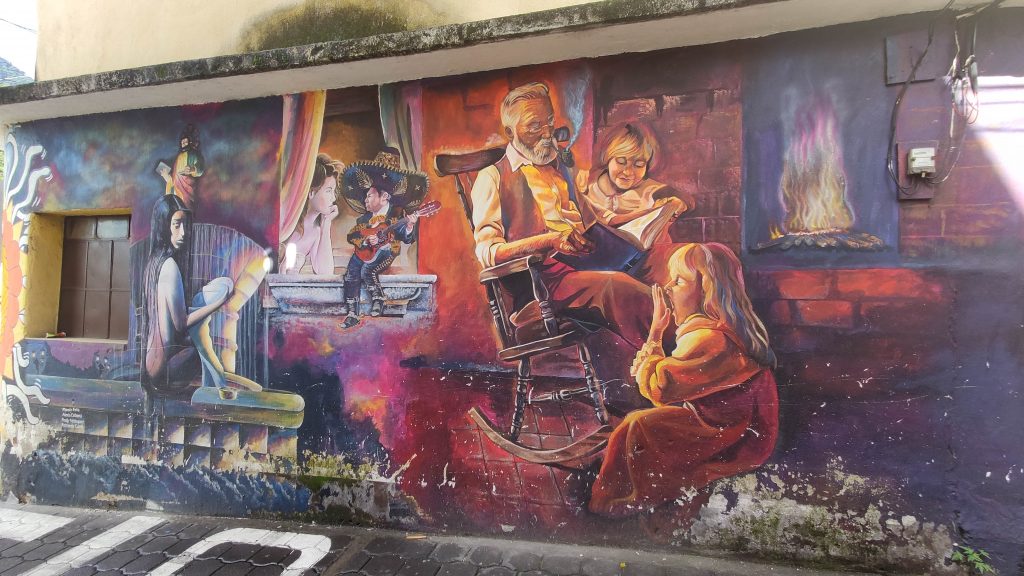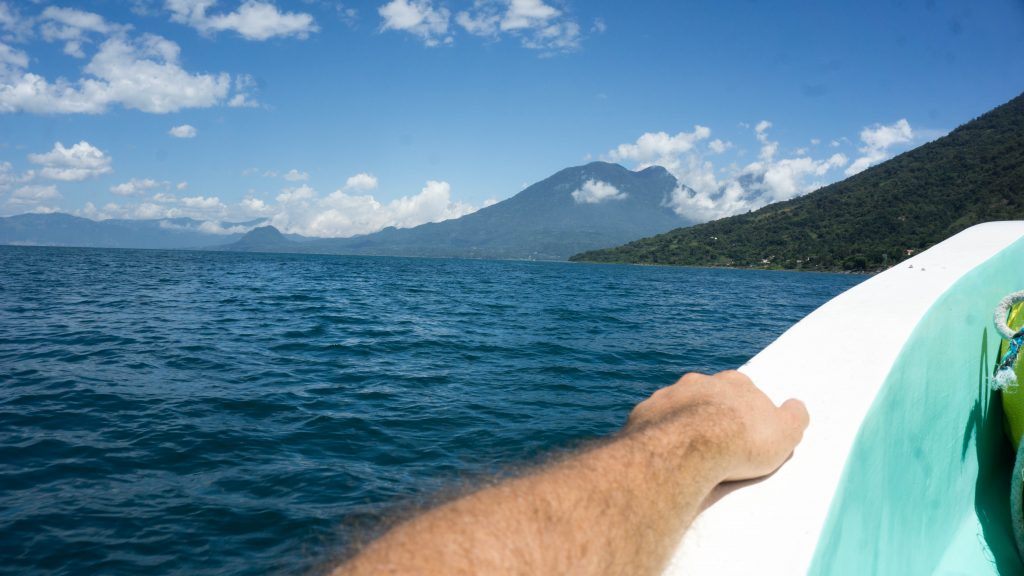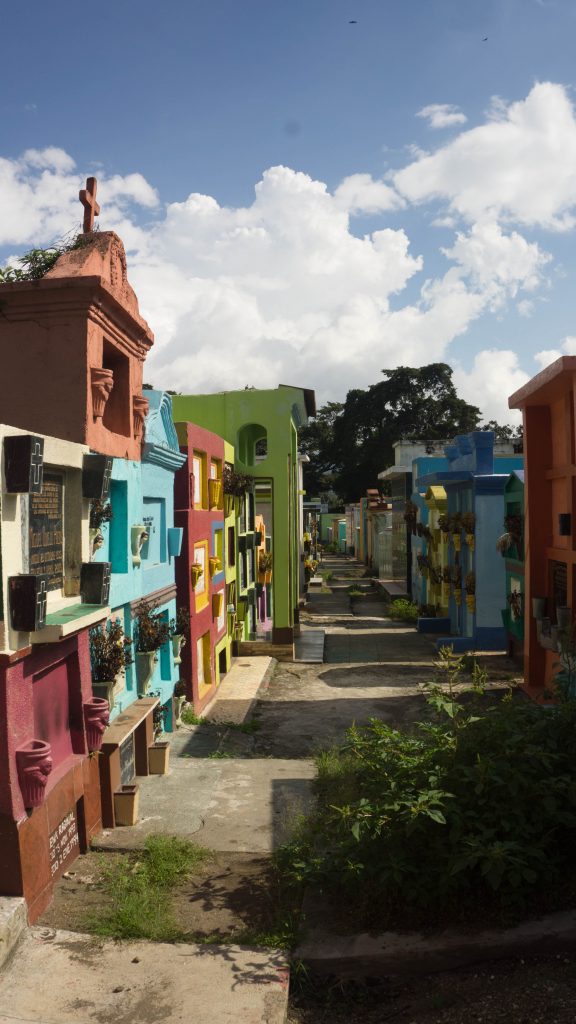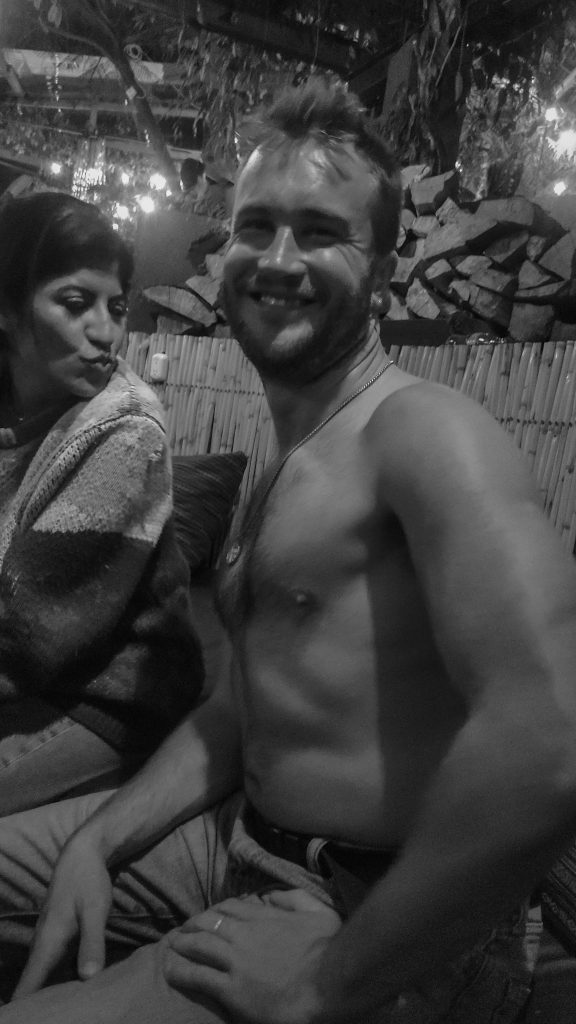The days just blend into one in the lake. One day becomes two, two become a week, a week becomes a month, and then all of a sudden, you’re having to look at which border you need to run across to get your visa renewed. But nobody minds; the time is not lost, and it certainly isn’t wasted. There is magic beside the lake, left over from a time way before we got there, way before the conquistadors, and certainly before anyone other than the Mayans knew of the place.
The lake, and the places that surround it, make living easy. The mountainous volcanoes cut the sky to a third, enclosing the whole place and making getting in and certainly getting back out a little too unappealing to do in a hurry. Once you’re in, you’re in, and the green, rolling mountains act like a blanket that tucks you in, making leaving feel the same as having to get out of a well-slept-in bed.

My days rarely felt empty at the lake. Most days, I had work to do. The sun would warm me through the windows, creeping over the far side of the water at about 6:30 a.m., meaning my mornings began easily at about 7. Waking up with the sun became commonplace, and not once, bar a few nasty hangovers, did I wake up feeling sluggish or groggy.
The clean mountain air, at a solid 1.5 thousand meters, was nothing but fresh, even with Coco’s incessant smoking. My kitchen was only covered by two walls; the other two were open to the elements and looked out over the entire range of Atitlan. A half-hour morning of grinding fresh Guatemalan coffee and cooking eggs couldn’t have been easier.

A few hours of work, sat with a view like that, flew by. I lived above a tuk-tuk garage, and at about 9 a.m., the drivers would arrive to start their daily drives. TukTuks, despite being apparently indestructible, sound like what I imagine fighter jets would sound like if chipmunks invented them. They can rattle the roof off a bunker and absolutely never start in the morning without revving their engines to the red line.
Despite the tuk-tuks, it was quite peaceful in my little apartment on the outskirts of San Pedro. In the night, there were packs of wild dogs that liked to roam the streets, shouting at things at all hours of the night, but I got used to that. 15-ton flatbeds also used to slam through their gears as they came hurtling down from the volcano behind my house, gear braking to the point where I think at least some of the space junk is a few of their pistons.
But apart from the dogs, the tuk-tuks, the flatbeds, and the guy who sells coconuts, it was relatively peaceful, certainly enough for me to happily work outside until it was time to get on with the rest of my day.

I would usually finish working around 11 am: A solid 4/5 hours of work, which is quite frankly obscenely long, and I am certainly pushing myself toward burnout. If I had lessons, this would give me three hours to do my chores, like popping to the market, making myself lunch, having a swim, and practicing my Spanish. If I managed two of these, it was a good day. Spanish was rarely done, and Elena would always know.
The Pueblas of Atitlan
On my days without Spanish class, Lake Atitlan beckoned. The glistening expanse is ringed by beautiful towns, all accessible for a few pounds, by high-speed, lightweight boats, often driven by children. These boats were capable of obscene speeds on the water. They are all made of fiberglass that has clearly been molded to the same mold in three different sizes. They weigh so little you could probably pick them up, and they can hold maybe 50 people a time.
These boats have enormous outboard engines on the back that throw the front end way into the sky. They skip along the surface of the water, barely making contact when they’re not full of people. A number of times, the drivers had to rearrange the people sitting in the boat because the weight distribution would have sunk the thing on one rogue wave. It was fun to watch people sit in the bow on a choppy day and see their spines slowly compress from the piledriver movement of the waves.

These boats would take you anywhere around the lake for a price. Locals pay half what the tourists do, and that is fair enough. Rich Westerners are overrunning San Pedro, and it’s only fair that the locals make their fair share of the profits. Too many of the prime spots have been bought up by Western hands, and they’re keeping the money in the same banks it came from in the first place. If the locals don’t profit from modern, capitalist colonialism, then there is no way it can ever be argued for and no way I can feel good about the way I travel. I’m not about to start volunteering and building a fucking school.
Each little town has its own flavor. San Marco is the epicenter of monetized spiritualism. Akin to televangelism, you can pay a huge wedge to become saved and spiritually cleansed by some dude with long hair who claims to know the answer. In actual fact, he just has too many pairs of harem pants, stinky dreads, and a skin condition he still hasn’t got looked at since his trust fund gap year to a monastery in Thailand.

My problem with San Marco is that any of the activities you can take part in there, whether it is ritual asphyxiation or undrugged dancing, is too expensive for any of the locals to even think about doing. Perhaps if there was a cheaper price for locals and another for tourists, I wouldn’t have such a problem with its exclusivity or predatory practices.
Panajachele is the entrance point for most people at the lake, sitting right at the opposite end of the 12km of water. It is the party place for most, and not a bad day out. I spent a day there in a lakeside resort that had a heated infinity pool, a cool deep pool, volcano views, and its own private beach. In typical Guatemalan fashion, they don’t care if you stayed at the resort, bought anything, or just wanted to use the free towels, it was fair game, and anyone is welcome.

The main town on the lake was tucked into a cove. Santiago had everything from the outside world that the rest of the world had missed out on. I didn’t spot a supermarket, but I did find a Domino’s. It was also interesting to see that everything the rest of the little towns were peddling, like leather goods, beautiful fabrics, and top-tier sombreros, were all available for a quarter of the price.
Coco and I spent a day wandering around the place, making our way to the local lookout spot and a walk around their cemetery. What struck us was the color of the place. Every house on the mountain was grey. Houses around the lake, unless very old, are made of breezeblock, and Santiago had not plastered, painted, or rendered a single one of them. The entire hill looked like a nuclear fallout shelter, and it was a fucking eyesore.

However, the traditional Guatemalan dress, which almost every woman in the area wears, is stunningly beautiful. Thick, rich-colored fabrics make up the wrap-around, ankle-length skirts, and equally vibrant blouses adorn their tops. Each group of Mayans has a different color scheme, similar to Tartan, and they’re all wonderful. Their cemeteries are similarly bright and exciting. They just don’t put much thought into cladding.
On our way home from Santiago, Coco and I were rushed to the ‘last boat back’ by a little dude in short trousers. By his rapid gait and hurried hand signals, we thought we may be just in time. Alas, we sat on that boat for an hour and a half before we made our way home. So it goes.

Directly next to San Pedro lies San Juan, a cute little town known for its stunning mirador and painted streets. The entire road down to the lake, from almost the top of the town, is painted with traditional Mayan art. It’s a sight to behold and a tax on the legs.
Alyssa and I made our way up the Mirador one afternoon to take in the sights. As is always the risk in rainy season, about ¾ of the way up, the skies opened. We just about made it to the summit before it really came down, and we weathered it out in a little tin and wood shack, watching the heavy, angry clouds roll across the lake. The sound of the rain on the roof, and the close, warm air, was remarkably soothing. As we sat there, we could see the blue skies a few kilometers away slowly making their way towards us, and within a half hour or so, we were back in the perfect blue of a typical Atitlan day. Rain is rarely a dampener on a day when the weather is always spring, and life gives you the time to revel in whatever it is that’s going on around you. I don’t need a crusty juggler to teach me mindfulness, I just need to sit in the rain for half an hour

Endless activities
If the day didn’t call for a trip, then San Pedro would provide. Every Sunday, a BBQ would pop in in a bar with a pool. An old, grumpy, Texan pitmaster has set up shop down by the lake, grilling and smoking the best fucking BBQ I have ever eaten. Never again will I crave an undercooked, anemic-looking Walls sausage, lightly charred over a paraffin-soaked tin of carcinogenic coal. This guy had absolutely no idea how to talk to people, but good lord, man could BBQ. Sundays often entailed eating my hangover into oblivion and then quickly throwing my body after it. Meat sweats and food comas never felt so good.

Spending the day paddle boarding or kayaking was as simple as walking down the street and waiting for someone to pop their head out of a door and shout KAYAK at you. Everyone had one, and everyone wanted to rent it to you. With some very basic haggling and even more basic Spanish, it usually came to about £2 an hour, which is pretty reasonable. Paddle boarding isn’t worth £2 an hour, and anyone who says trying to stand up on an inflatable fucking ironing board is better than sitting in a comfortable, accommodating craft with dual paddles is a liar and probably loves doing tantric yoga in San Martin. Hilariously, the Kayaks are also made of the same fiberglass painted over a mold. This makes them rather unsteady and hideously lumpy. They looked almost organic.
Every day Lake Atitlan Spanish School hosted a new event for the students. They took place after class, and they ranged from talks on the history of the town, which I never went to because I’m not a nerd and I don’t speak Spanish, to chocolate-making classes, which I did go to because I got to have a captive audience, got to eat loads of chocolate, and could recruit people for my favorite activity in all of San Pedro…

By far, my favorite and most regularly pursued activity was/is drinking. It was great. Drinks were cheap, everywhere was within walking distance, the music was regularly passable, and all the bars, minus one of my faves, were built out over the lake. As the sun set and the lake lit up, it was a joy to take in the view and suck down endless rum and cokes for a fraction of the price of the UK. The rum was local, the Coke made with delicious, diabetes-inducing corn syrup, and the little wedge of lime in it managed to keep my scurvy at bay.
The nights had pretty much all you need, depending on your requirements for getting pissed. El Barrio was the cute locals’ bar, propped up by aging lost souls, sipping on their whiskeys and chewing their bitterness. The barman, Crispy, was another victim of the San Pedro trap and had meant to visit for one week but ended up staying for 10 years. He is a magnificent barman who remembers your name and would always say hi on the street. El Barrio is buried in the one-person-wide roads of the old town and was the place I would go to have a few sat at the bar and listen to some drifters’ stories.
Mr. Mullets is a sexually depraved, drug-addled cesspit worked by volunteers who take that description and wear it on their sleeves. The hostel is notorious around the country and is run by three 20-somethings who have turned it into gold. No visit to San Pedro is complete without wading your way through the muck and rotting air of Mr. Mullets, even if it is just the once. I rarely left there with both my eyes coordinating.

But I spent most of my days in Sublime. The place is huge, spanning three/four levels going all the way to a jetty by the lake. The sprawling building is open most of the day, and I rarely found a time it was empty. The drinks aren’t the cheapest, but when it is £2.50 a beer, and £1.50 a Cuba Libre, I’m not going to go around moaning. As closing time comes around, which can fall between midnight and three, the bar begins to empty. But, far from being a definite, aggressive closing time, instead, the staff round up all the stragglers, no matter how far down the ketty, rum-colored rabbit hole they have fallen, and cart them off to the after-party. Nobody is an unwelcome newbie in San Pedro, and everyone is always welcome. In San Pedro, the party is for everyone.
Oh, and you know I found a gym there, Manos de Dios was a shithole, and I got stacked, as always. (JK, I plateaued years ago)




2,570 Responses
Brilliant